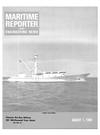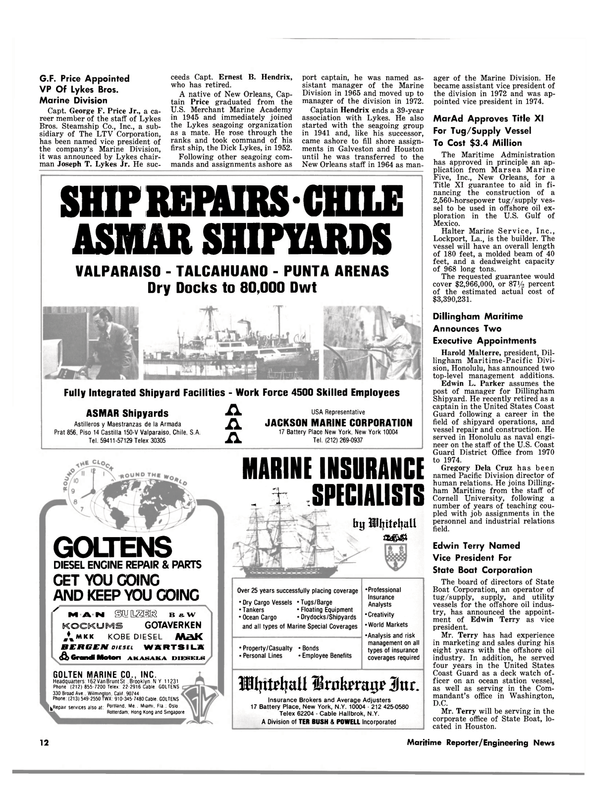
Peterson Delivers Big Tuna Seiner, Launches Another
A large contingent of the San Diego and San Pedro tuna fishing industry gathered in Sturgeon Bay, Wis., recently to witness the christening and delivery' of the tuna seiner Captain Frank Medina, built for Capt. and Mrs. Joe Medina Jr. of San Diego; and the launching of the Jane for Venatun, S.A. of Caracas, Venezuela.
Sponsor of the Captain Frank Medina was Miss Deborah Ann Medina, daughter of the owners, assisted by Mrs. Mary Ann Medina, wife of Steve Medina, Captain Joe's son who will be navigator onboard the vessel. The boat was named for Captain Joe's uncle, a pioneer San Diego tuna fisherman.
The Jane was named for and sponsored by Mrs. Jane Real, wife of John Real, president of Star- Kist Foods Inc. of San Pedro, Calif. She was assisted by Senora Concepcion Aramburu Villaneuva of San Sebastian, Spain. The seiners will fish for StarKist and are being built under a contract signed in July 1978 between Peterson Builders, Inc., and Ocean Blazer, Inc.
The Captain Frank Medina departed Sturgeon Bay on her dilivery trip to Panama via the St.
Lawrence Seaway. A high point of the trip was a stopover in Toronto where Captain Medina and the boat's namesake, Capt.
Frank Medina, had the opportunity to display it to the sizeable Portugese community there, which includes relatives of the Medinas.
The Captain Frank Medina represents Peterson's latest development of a design prepared by Ivo Zaninovich of San Diego. She is 225 feet by 41 feet by 19 feet, and will pack 1,200 tons of tuna in 17 refrigerated wells. Her GMElectro- Motive Division 20645E7 engine permits the craft to achieve speeds of up to 16 knots.
Electrical power is supplied by three Caterpillar D353 engines driving Kato 300-kw/480-volt generators.
The Schottel 48-inch bow thruster is driven by a Detroit Diesel 12V-71N engine rated 400 bhp at 2,100 rpm. The bow thruster is interfaced with the Sperry autopilot system to permit automatic heading keeping with the main engine shut down.
The deck machinery hydraulic system was designed and furnished by MARCO Seattle, and is powered by a dedicated Caterpillar D353E engine rated 470 bhp at 1,225 rpm. A standby main hydraulic pump drive is installed on the forward end of the port auxiliary generator, while an 80-hp electric motor/pump unit provides power for the anchor windlass, forward deck Husky crane and speedboat davits. A MARCO WS444 Superseine winch and 54- inch power block with power grip are principal features of the deck machinery complement.
The refrigeration system was furnished by Vilter Manufacturing Company of Milwaukee, and includes four eight-cylinder compressors circulating ammonia through approximately 26,000 feet of galvanized pipe coils in the wells.
The electronic complement is unusually complete and includes two Sperry MK126E radars, a Furuno 850B scanning sonar, Baymar recording depth indicator with Paragon digital readout, Taiyo marine band ADF and VHF automatic direction finders, two Hull single-sideband radios (one with Northern N541 1-kw linear amplifier), a Morrow model SSB- 150 emergency SSB radio with programmable scanner and emergency tone generator, a King K195 aircraft band radio, two Kenwood two-meter VHF radios, two Hygain model 655 VHF-FM-radios, a Magnavox 1242 satellite receiver, Furuno weather facsimile receiver/ printer, Yaesu all-band receiver, Regency VHF scanner, and a complete ham radio installation in the navigator's stateroom. The radio installation was engineered by Honor Marine Communications Inc. of San Diego and installed by Peterson Builders' technicians.
The craft is equipped to carry a Hughes 300 turbine-powered helicopter, which joined the ship en route. Twelve thousand gallons of turbine fuel is carried in double bottom tanks for the helicopter, and filtration and pumping is provided to supply the fuel to the helicopter deck.
Peterson Builders fabricated the two speedboat davits and bridge deck speedboat crane that permit rapid launching of all five aluminum chaseboats. They are equipped with Volvo Aquamatic inboard/outboard units. Three thousand nine hundred gallons of fuel is carried for the chaseboats.
Special care was taken with the interior and accommodations of the vessel, which represent a new standard in habitability. Mrs.
Carolyn Medina took a personal interest in and directed the interior decorations and appointments, working with Peterson Builders' design staff and carpenters.
Other major equipment installed on the vessel includes two Westphalia model OTA7B fuel oil centrifuges, Pacific Pumping brine circulating, transfer, bilge, condenser cooling and general service pumps; Buffalo Forge fans; Red Fox sewage treatment plant; Federal Pacific switchboard; Cutler Hammer controllers; Waukesha stern bearings and seals; Coolidge five-blade, stainless-steel propeller; Star Machinery electric cargo hoists; Crosby blocks and wire rope rigging and Marlite doors and paneling throughout.
The vessel was painted with epoxy and urethane paints applied using a system developed and supplied by Pro-Line Inc. of San Diego.
The Jane will join the fleet of Venatun, Inc. in the fall of 1980, j o i n i n g the highly successful Peterson-built Napoleon, which began fishing at the end of December 1979.
Peterson Builders' general manager Joe Gagnon announced that construction had begun on a series of three boats for delivery in 1981 to an undisclosed owner, affirming Peterson's establishment as a respected top-quality builder of tuna purse seiners. A formal announcement of the new contract is expected shortly.
Read Peterson Delivers Big Tuna Seiner, Launches Another in Pdf, Flash or Html5 edition of August 1980 Maritime Reporter
Other stories from August 1980 issue
Content
- Tracor Offering Paper On Integrated Navigation Systems page: 5
- J.J. Bajor Will Head Newly Formed Keppel Marine Agencies Inc. page: 5
- Equitable Delivers Multipurpose Cargo Vessel M / V Amazonia page: 6
- Red Fox Will Build Jackup Barges At Newly Acquired Yard page: 6
- James Steadman Joins Halter Marine As VP For Special Assignments page: 6
- New Jackup Drill Rig Christened At Beaumont Yard Of Bethlehem Steel page: 8
- Patrick Keene Named Director Of Operations At Ingalls Shipbuilding page: 8
- Simrad Introduces New Trawl Echo Recorder- Literature Available page: 8
- Robert Strasser Joins MacGregor, U.S.A. As Technical Director page: 8
- Three Free Reports A v a i l a b l e From Ship Structure Committee page: 9
- Strickland Appointed Director Of Salvage For Crowley Maritime page: 9
- Bird-Johnson Appoints Richard E. McGinnis A Trustee And Director page: 9
- Halifax Shipyards Gets C$27-Million Order For Three Stern Trawlers page: 9
- Peterson Delivers Big Tuna Seiner, Launches Another page: 10
- Advanced Design Product Tanker Launched At Sun Ship page: 10
- Coast Guard Approves Butterworth Systems Oil/Water Separators page: 10
- New Bulletin Describes Improved Diesel Cylinder Liner Plating Process page: 10
- G.F. Price Appointed VP Of Lykes Bros. Marine Division page: 12
- Army Permit Clears W a y For Deep-Draft Terminal In Galveston page: 12
- Shipyard Finds Safe Product Without Sacrificing Performance page: 12
- HUDSHIP Enters Export Market With Offshore Supply Vessel page: 13
- Zapata To Acquire Offshore Services Ltd. From Trafalgar House page: 13
- Furuno Announces New Model Radar Alarm- Literature Available page: 14
- Agri-Trans Announces Five Key Promotions In Management Staff page: 14
- Improved Sales And Earnings Reported By Todd Shipyards—Has $1,5-Billion Backlog page: 15
- ITO Announces Six Promotions—R.J. Nolan Named Executive VP page: 15
- Technical Report On Sea-Shed Conversions Available From MarAd page: 15
- Ogden Equips Fleet With Satellite Navigators page: 15
- Nav-Com Relocates To Larger Quarters page: 16
- $4.7-Million Contract Awarded By U.S. Navy To Savannah Machine page: 18
- Maumenee, Roy And Snellman Promoted At Alabama Dry Dock page: 18
- Appledore And DnV To Assist In Operation Of Okpo Shipyard page: 18
- Michigan Wheel Announces Formation Of Propulsion Systems Group page: 18
- Marland Has New MSD For Smaller Vessels- Literature Available page: 20
- Waller & Associates To Provide Engineering Services For Ingram page: 20
- Two Hitachi Yards Deliver Bulker And Product Carrier page: 21
- San Francisco To Build New Fireboat Designed By Morris Guralnick page: 21
- Halter Delivered 30 Big Commercial Vessels In First Half Of 1980 page: 22
- James Rhodes Appointed Communications Director For Navidyne Corp. page: 22
- French Appointed VP-Program Support At Sun Ship—Three Other Support Posts Filled page: 23
- Dieselcare 80 Seminar Scheduled In New York October 28-29, 1980 page: 24
- B&W Yard Given Danish Gov't Guarantee For Bulk Carrier Construction page: 24
- Transoceanic Designated As U.S. Forwarder For NACAP Project page: 26
- Griff Lee, McDermott VP, Elected To National Academy Of Engineering page: 28
- James J . Murphy Named VP-Marketing For General Dynamics' Marine Group page: 28
- New Report Confirms Fuel Efficiency In All Transport Modes page: 29
- Lucander And Dowhos Form Design Association page: 29
- $278-Million Contract Awarded To Wartsila By V /O Sudoimport page: 30
- PSI Announces Contracts For ACOE Dredges page: 31
- Maritime Association Names Parkhill New President, Buckley, VP page: 31
- American Manufacturing Announces Three Sales Appointments page: 32
- Gene Ossi Establishes New Automation Firm- Brochure Available page: 32
- Trikora Lloyd Buys Three Ships At Total Cost Of $45 Million page: 32
- Michael Warren Joins Farboil As National Accounts Manager page: 32
- FMC Launches Big Deck Barge For Puget Sound Freight Lines page: 34
- Joy Manufacturing Has Literature Available On New Clutch Assembly page: 34
- Brochure Available On JLG Industries' Aerial Work Platforms page: 34
- Dravo SteelShip Delivers Towboat To Pleasants Power Station page: 34
- Dillingham Forms New Subsidiary To Operate In Gulf Coast Area page: 34
- Hydranautics Awarded BP Magnus Field Platform Contract page: 34
- Collins Elected President And General Manager Of Houston Systems Mfg. page: 34
- Multipurpose Cargo Vessel 'Sarita' Delivered By Hitachi page: 34
- Haggerty Joins APL As Managing Director Of Atlantic Region page: 35
- IHI Awarded Contract To Build Two VLCCs For Kuwait Government page: 37
- Gillen's Names Three To New Executive Posts page: 37
- Raymond To Join In Building $30-Million Yard In Malaysia page: 37
- David Jackson Appointed Vice President For Sun State Marine page: 37
- New MMC Gauging System Meets IMCO Guidelines- Literature Available page: 37
- K.J. Funk Named VP-Sales, E.F. Carrigan Sales Director For Jeffboat page: 38
- Thomas A. King Named New Superintendent Of Merchant Marine Academy page: 38
- Farrell Lines Announces Three New Appointments— Breslin To VP-Controller page: 38
- Gaston Joins Bulkfleet Marine As Manager Of Engineering Services page: 38
- C.A. Tomassoni Joins Designers & Planners In Design/Economics Post page: 39
- Garlock Introduces Asbestos-Free Packing —Literature Available page: 39
- Hamburg To Host World's First Trade Fair On Port Planning/Operations page: 39
- Three New Managers Appointed By CDI Marine Company page: 39
- Hayward Marine Products New Name For Former Mechanical Marine page: 39
- Miles Heads Barber Blue Sea Activities In North America page: 40
- First Vessel Extruded From Covered Hall At Cammell Laird page: 40
- $79-Million Jackup Rig Ordered By Nedlloyd From Hitachi Zosen page: 41
- McDermott Division Gets Two Contracts For Irish Sea Gas Projects page: 41
- Coal-Fired Marine Boilers page: 42
- Cameron Refits Drill Rig 'Western Pacesetter II' In Record-Breaking Five Days page: 42
- New Company Plans To Build Two Bulk/Container Ships At Cost Of $156 Million page: 42
- Evergreen Handt Merged Into Evergreen Marine— Hansen Named President page: 44
- Carriere Named Manager Of Lykes M&R Division In San Francisco page: 44
- German Yard Launches U.S.-Flag Trailership page: 48
- IMODCO Gets $14-Million Mooring Terminal Job Offshore Abu Dhabi page: 50
- Brochure Available On Six Operating Divisions Of Grinnell Valve page: 51
- New Zapata Tug Tows Crewboat To West Africa page: 52
- Unique Supply Lighter Launched By MARCO Seattle page: 52
- I.C. Kizilkaya And John Slager Have Joined Designers & Planners, Inc. page: 53


